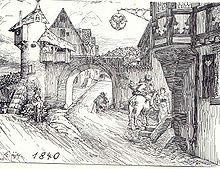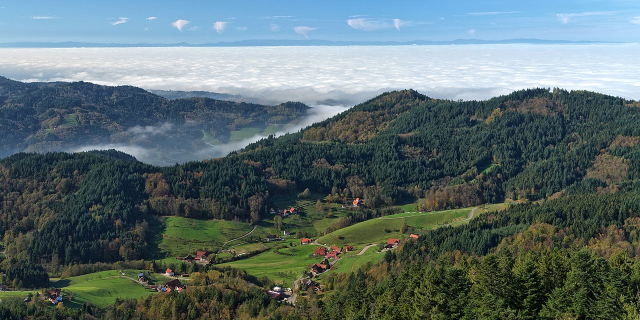Schiltach is a town in the district of Rottweil, in Baden-Württemberg, Germany. It is situated in the eastern Black Forest, on the river Kinzig, 20 km south of Freudenstadt.
 1643 townscape by Swiss engraver, Matthäus Merian, showing the castle above the town of Schiltach
1643 townscape by Swiss engraver, Matthäus Merian, showing the castle above the town of Schiltach Lower gate by the Gasthaus Adler until 1840
Lower gate by the Gasthaus Adler until 1840 Upper gate by H. Eyth (until 1840)
Upper gate by H. Eyth (until 1840) 1533 account of the execution of a witch charged with burning the town of Schiltach in 1531
1533 account of the execution of a witch charged with burning the town of Schiltach in 1531Even in Roman times the road through the Kinzig valley was already part of a link through the Black Forest from the Strasbourg area towards Rottweil.
Schiltach was founded in the 11th century as a parish for the surrounding farms, which are older than Schiltach. Around the town church, which today stands in the town district Vorstädtle and is evangelic, rose a settlement named after the River Schiltach. The Dukes of Teck probably founded the town of Schiltach in the middle of the 13th century to secure their territories. They built a surrounding town wall with gates and a castle above the town. They did not build a church because Schiltach already had one.
The town was intended to act as a stop for travellers and as a trading post before the road descended to Rottweil. From about 1250, the castle and town took over the function of the Willenburg, which had guarded the road before the founding of Schiltach.
In 1371 Schiltach was transferred to the Dukes of Urslingen. After ten years, the impoverished dukes of Urslingen sold the castle and town to the Dukes of Württemberg. Württemberg retained Schiltach until 1810 except the years from 1519 to 1534, when Schiltach was occupied by the free imperial city of Rottweil and later (like the whole Duchy of Württemberg) by Further Austria.
In the "Gränzvertrag zwischen dem Königreich Württemberg und dem Großherzogthum Baden"[1] (border treaty between the Kingdom of Württemberg and Grand Duchy of Baden), which was negotiated in Paris on October 2, 1810, several areas of the Oberamt Hornberg, besides Schiltach also the town of Hornberg and the communities Gutach and Kirnbach, got to the Grand Duchy of Baden. Wolfach became the new Amststadt of Schiltach and later the county town. The surrounding farm became as Lehengericht, an own community.
In 1952, Schiltach went to the state Baden-Württemberg. The county of Wolfach was dissolved in 1973 and Schiltach was allocated to Rottweil. The community of Lehengericht was reincorporated into the town of Schiltach in 1974. In 1979 the exclave of Sulzbächle/Fischbach went to the town of Wolfach, in return the area of Vor Heubach went to Schiltach.
ReligionsDuring the Protestant Reformation, Schiltach was a part of Württemberg so it was Protestant, like the territorial lords. It did not change until the 19th century when, because of industrialisation, more and more Catholics moved in. Today in Schiltach there are Protestant and Catholic communities as well as a New Apostolic community and various minor religious communities.
The Evangelical (Protestant) town church (Stadtkirche) was built in neo-Byzantine style after the old Gothic church burned down. The Catholic Church St. Johannes der Täufer was blessed in 1966 as successor of the old catholic church from 1899, which had to be replaced because of its small size. The New Apostolic Church at the Hauptstraße comes from the 1980s. The old New Apostolic church in Schenkenzeller Straße still has the characteristic cross on the roof but, despite its size, is used as a residential house.Incorporations 1934: Area of former Habershof 1936: Area Kuhbacher Hof 1 April 1974: Community Lehengericht 1979: Area Vor HeubachEmblem
Today's town emblem was adopted of the Dukes of Urslingen. The emblem became free to use as the last Urlinger, Duke Reinhold IV. of Urslingen died in 1442. Probably it was conveyed by the Count Ludwig of Württemberg, which was a patron of the town.
The emblem shows three red shields in a white field. Almost the same emblem can be found in Alsace at the house of the Rappolstein, which castle stands above Ribeauvillé. A member of the Ursling family married into Rappolstein family.
































Add new comment